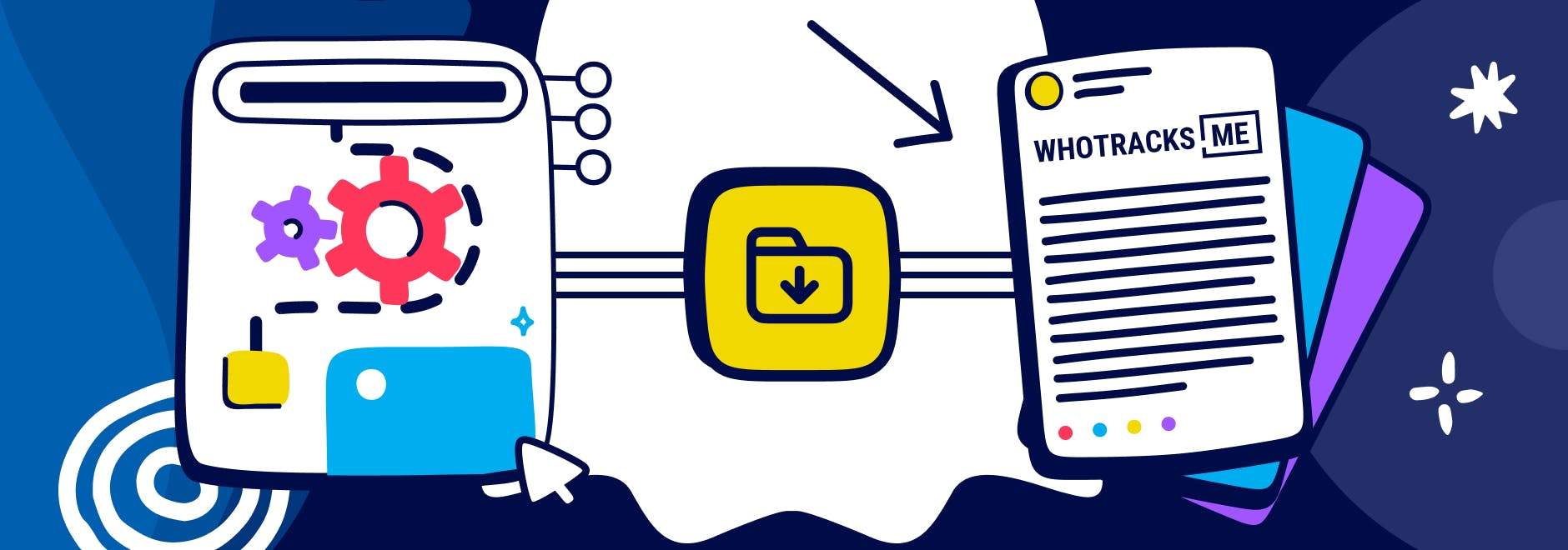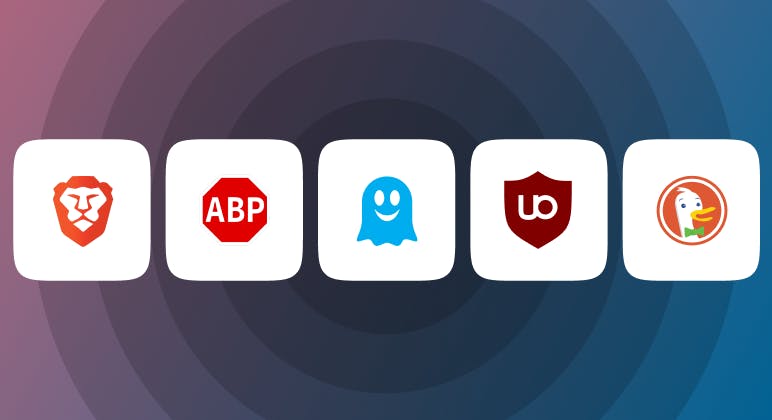WhoTracks.Me
How To Use Adblock Filters
- Load the data from WhoTracks.Me to get access to trackers' information
- Create a mapping from tracking categories to list of domains
- Filter each domain based on the amount of tracking of each app
- Generate a filter list for each category
The full source code used in this article can be found on the Github repository.

The Role of Adblock Filters
Most popular content blockers are using adblock filter lists to decide what requests leaving the browser should be blocked. In this regard, filter lists act as a privacy ground truth: deciding what is safe, and what is not safe for users. It means that your privacy protection is only as good as the filters your are using. The community is doing an amazing job, but still there can be gaps in your protection; one such situation is when a new tracker appears.
With the right data, updated regularly, we believe it is possible to build powerful tools to help increase users' privacy. Knowing more about trackers, in real time, allows to provide better anti-tracking but can also help the tedious process of curating the filter lists.
In this post we'd like to demonstrate how we can make use of the open-sourced WhoTracks.Me data to automatically generate up-to-date, per-category, filter lists supported by the most popular ad-blockers out there. Leveraging this data can improve user experience and make maintaining the lists easier.
Ghostery can imagine generating also per-country lists as a future task, in the spirit of the different easylists already in existence:
- DEU: Pornvertising blocking Germany
- DEU: Site_Analytics blocking Germany
- or
- FR: Site_Analytics blocking France
They could also be dispatched in the already existing lists such as advertising, privacy, etc. Another option could be to use this as a tool to assist maintainers to keep an eye on the ecosystem; allowing to learn about new trackers in real time.
Let's get started!
Loading the data
The first step is to install the whotracksme package, available on PyPI and Github. You can get started by installing whotracksme with pip:
$ pip install whotracksme
We start by loading the tracker-related data from trackerdb.sql, using the helper function found in the whotracksme.data module:
from collections import defaultdict
from whotracksme.data import load_tracker_db
# Categories to tracker domains
tracker_domains_per_category = defaultdict(list)
# Keep track of normalized "app" name for each tracker domain. A given "app"
# such as "doubleclick" can use several domains: 2mdn.net, doubleclick.net, etc.
tracker_domains_to_app = {}
# Load trackers and group them by category
sql_query = """
SELECT categories.name, tracker, domain FROM tracker_domains
INNER JOIN trackers ON trackers.id = tracker_domains.tracker
INNER JOIN categories ON categories.id = trackers.category_id;
"""
with load_tracker_db() as connection:
for (category, tracker, domain) in connection.execute(sql_query):
tracker_domains_per_category[category].append(domain)
tracker_domains_to_app[domain] = tracker
Here is a sample of what we get in tracker_domains_per_category. Note that if you run the same script, you might get slightly different results as the data is being constantly updated:
defaultdict(list, {
'advertising': [
'doubleclick.net',
...
],
'audio_video_player': [
'soundcloud.com'
...
],
'cdn': [
'googleapis.com',
...
],
'comments': [
'disqus.com',
...
],
'customer_interaction': [
'zendesk.com',
...
],
'essential': [
'googletagmanager.com',
...
],
'extensions': [
'kaspersky-labs.com',
...
],
'hosting': [
'amazonaws.com',
...
],
'misc': [
'linkedin.com',
...
],
'pornvertising': [
'pornhub.com',
...
],
'site_analytics': [
'google-analytics.com',
...
],
'social_media': [
'twitter.com',
...
]
]})
Filtering based on tracking behavior
It is tempting to generate filters for each domain loaded so far, but it would be very aggressive. Indeed, some domains identified as potential trackers might in fact send little or not at all unsafe identifiers. For example createjs is not using any fingerprinting and does not seem to be doing tracking via cookies, hence, it should not be blocked systematically.
Fortunately, we can make use of the data from apps.json to learn more about each tracker. An app is an entity which can contain several domains (e.g.: doubleclick is an app for which we identified three domains: 2mdn.net, invitemedia.com and doubleclick.net). We also provide information about companies to which each app belongs, but we will leave the exploration of this data for another article.
import json
from whotracksme.data import load_apps
apps = load_apps()
apps is a dictionary with keys being app ids (e.g.: google_analytics) and values containing all we know about each app. Let's take an example:
apps["google_analytics"]
{
"overview": {
"bad_qs": 0.4377430033329568,
"content_length": 14771.492718357234,
"cookies": 0.0015869678941083753,
"https": 0.7507222054912428,
"id": "google_analytics",
"reach": 0.44292899275150094,
"requests": 3.834100333790446,
"requests_tracking": 1.202157901660253,
"site_reach": 0.616005569531587,
"tracked": 0.4383474801843971
},
"history": ...,
"rank": ...,
"sites": ...
}
Assume that everything is already accessible
That's a lot of data, and we plan to release a more complete documentation about what all this is about soon. For now let's just assume that everything is already made accessible on the website, in form of nice graphs and aggregations!
For our use-case, we will only consider the field: tracked. It represents the proportion of page loads including app, identified as performing some form of tracking (using either identifying cookies or fingerprinting). In the case of google_analytics, it means that out of 100 page loads where google_analytics was present, tracking occurred 44 times.
Before generating the ad filter list, let's keep only apps tracking users more than 10% of the time. Note that finding the right threshold would require some finer analysis, and could depend on the application.
def filter_domains(domains):
for domain in domains:
app_name = tracker_domains_to_app[domain]
if app_name in apps:
app = apps[tracker_domains_to_app[domain]]
tracked = app['overview']['tracked']
if tracked >= 0.1:
yield domain
We need to check if the app exists first because we currently only have the top 500 hosted on Github. We will host more in the future.
Generating the lists
We now proceed to generate the filter lists from these domains. They can take two forms:
- ADB compatible syntax: ||{domain}$third-party
- Hostname syntax: 127.0.0.1 {domain}
Note that the second option will probably be too aggressive in a lot of cases, as it will also block the domain even if they are first-party (e.g. google.com might get blocked by these rules).
def generate_adb_filters(domains):
"""Given a list of domains, generate filters using the
ADB syntax to be used in an adblocker"""
for domain in domains:
yield f"||{domain}$third-party"
def generate_hostname_filters(domains):
"""Given a list of domains, generate filters using
the hostname syntax"""
for domain in domains:
yield f"127.0.0.1 {domain}"
# Generate filters with *ADB* syntax
adb_filters = {
category: '\n'.join(generate_adb_filters(filter_domains(domains)))
for (category, domains) in tracker_domains_per_category.items()
}
# Generate filters with *hostname* syntax
hostname_filters = {
category: '\n'.join(generate_hostname_filters(filter_domains(domains)))
for (category, domains) in tracker_domains_per_category.items()
Each dictionary now contains a valid ad blocking list for each category:
hostname_filters.keys()
dict_keys([
'advertising',
'audio_video_player',
'cdn',
'comments',
'customer_interaction',
'essential',
'extensions',
'hosting',
'misc',
'pornvertising',
'site_analytics',
'social_media',
'unknown'
])
And here is what we get for example in the advertising category:
print(adb_filters['advertising'])
||doubleclick.com$third-party
||criteo.com$third-party
...
And the same domains but as hostname filters:
print(hostname_filters['advertising'])
127.0.0.1 doubleclick.com
127.0.0.1 criteo.com
...
Steps:
To put it in a nutshell, here is what we just did:
- Load the data from whotracks.me to get access to trackers' information
- Create a mapping from tracking categories to list of domains
- Filter each domain based on the amount of tracking of each app
- Generate a filter list for each category
There is so much more we can do with this database. At the moment the API to load the data is pretty-low level, but it will be improved over time.

